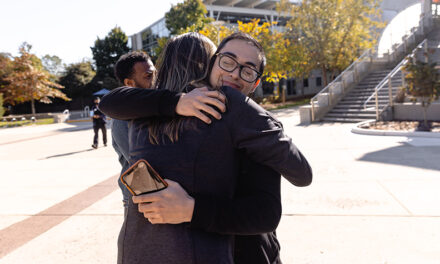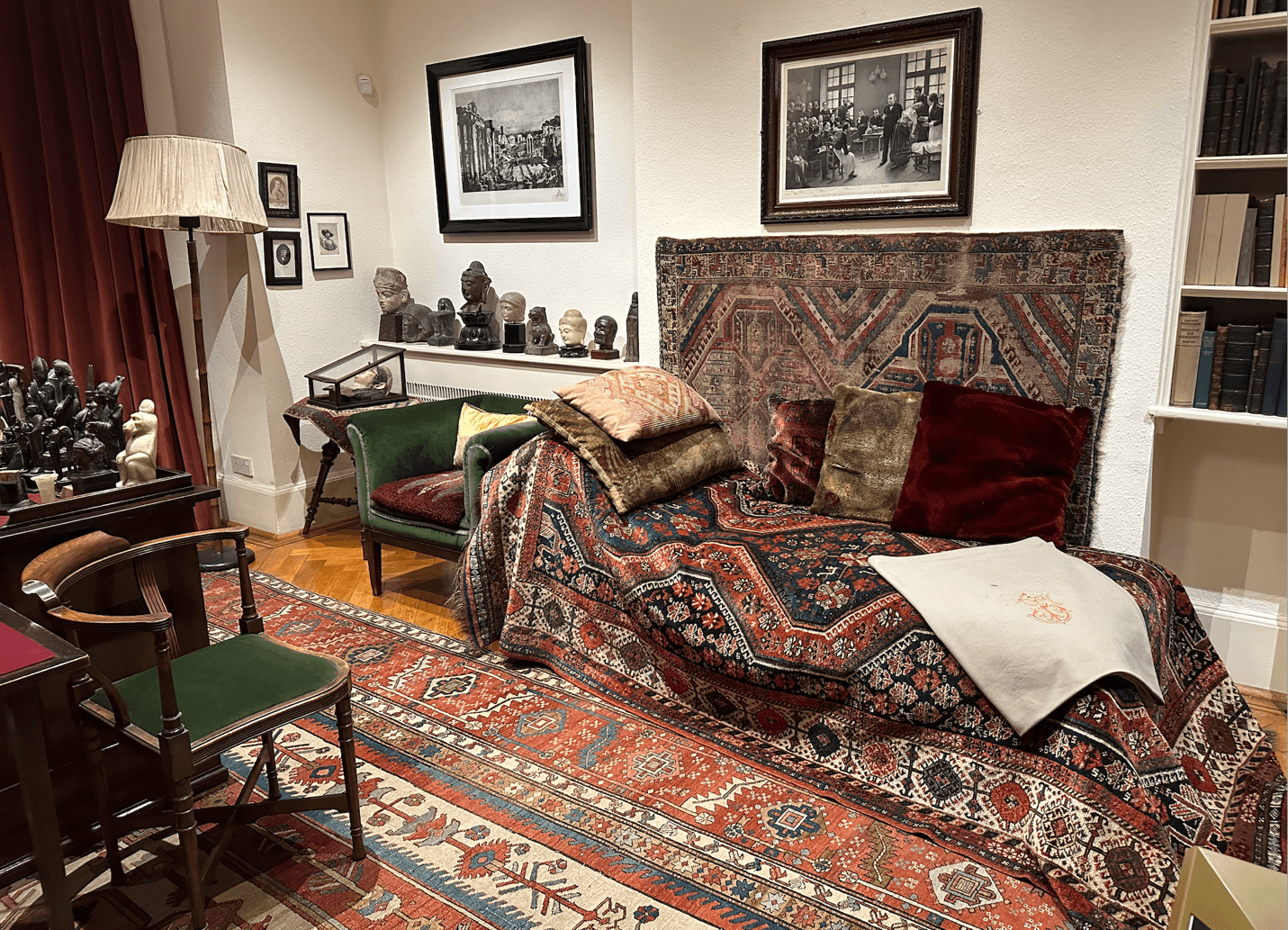
Freud’s study, Freud Museum, London, October 2023. Photo: The author.
Freud’s couch
Early in my art history education, I became fixated on Freud. It happened during the summer of 1977, when somebody gave me a browned copy of The Interpretation of Dreams. I read it like a mystery novel, and when I finished, I realized I had a handy tool with which to discover hidden meanings in works of art. I proceeded to collect and read nearly the complete works of Freud — whatever was available in cheap, paperback editions.
For a while, Freud impacted everything I wrote, thought, and spoke. My research papers all involved psychoanalytic explorations of given artists or artworks. At parties, I offered dream interpretations in five minutes or less. Words like “parapraxis” and “countertransference” infiltrated my conversations. I even bought a chaise longue for my little apartment in case any visitors wanted an analytic session. I was quickly becoming a bore. What saved me were new infatuations: Lévi-Strauss, Barthes, Benjamin, and Adorno. More unusually, I also read Marx and Engels. That nearly got me tossed out of the Ph.D program at Princeton a few years later; a couple of fellow traveler professors saved me.
I mention all this because of the deja-vu I experienced during a recent visit to the Freud Museum in London and the impact it had on my understanding of two brilliant exhibitions I saw earlier that day, Frans Hals at the National Gallery and Philip Guston at Tate Modern. It happened in Freud’s study while pondering the famous couch. I felt certain I had been there before, though I hadn’t. It wasn’t just the sight of the couch and the surrounding books and artifacts; they were familiar from photographs. It was a spatial and aural recognition. Even the smell of the old leather-bound books and wool carpets was familiar. Déjà vu, Freud believed, was the reactivation of a previous unconscious idea or impression – a return of the repressed. What was the thought or feeling I struggled to conceal? Later that night, as I reflected upon the paintings by Hals and Guston, I recognized the basis of my uncanny experience in front of Freud’s couch.
The Dutch “Golden Age”
Frans Hals was born in Antwerp in the southern Netherlands in 1582 during a dangerous time. Just six years earlier, the city was sacked by troops of the Spanish Habsburg Emperor, Phillip II. Hundreds of buildings were burned and some 17,000 people – including women and children – were killed by what was called “the Spanish fury.” A similar fate befell the city of Maastricht in 1579. Fearing more of the same, political leaders in the Protestant north prepared themselves. In 1581, they issued an “Act of Deposition of the Lord of the Low Countries, Philip II” – essentially a declaration of independence. There followed decades of intermittent warfare that only ended in 1648 when Spain – now close to bankruptcy – recognized Dutch independence by signing the Treaty of Munster.
The new, so-called “Dutch Republic, was no democracy. It was ruled by a self-perpetuating oligarchy that wielded un-contested political authority. This ruling class had few ties to European kings and queens, and neither sought a mandate nor permitted challenge from those below. This political consolidation, combined with exceptional access to maritime trade routes and seemingly inexhaustible fish stocks, enabled the nation to accrue greater economic wealth and political power than any other in the world at that time, except China. The Dutch Republic was in fact, hegemonic, meaning that its manufactured goods were cheaper and of higher quality than those of any other nation, allowing it to dominate the global market in everything that mattered. It even exercised a monopoly on trade with Asia.
What political contestation did exist in the Netherlands was chiefly internecine – between those who favored a strong central state led by a Stadholder, and those who preferred a more decentralized, federalist system. But this very political inwardness, combined with an intense concern with international trade and national manufactures, encouraged a materialism and empiricism that was highly conducive to development of the visual arts. Dutch men and women of all social classes – excepting the very poor – collected paintings and prints, leading to a flourishing of these art forms as never before.
Rembrandt van Rijn, Johannes Vermeer, and Frans Hals were the three greatest painters of the age, though only one of them, Rembrandt, was fully recognized at the time for his genius. In retrospect, it’s clear that all three understood – albeit in different ways — that Dutch Capitalism (they wouldn’t have used that word) generated poverty as much as wealth, and that an unyielding desire for profit takes a toll on body and soul. There is as much tragedy as triumph in their works. By the end of Hals’ long life, he had turned portrait painting into a vehicle for psychological insight, and possibly even social criticism.
Hals’ formation
In 1585, the Hals family fled the depopulated city of Antwerp with little but the clothes on their backs. They settled in protestant Haarlem to the north, where the artist’s father found steady employment as a cloth cutter. By around 1600, Frans was apprenticed to Karel van Mander, (today better known as an art historian than an artist), and in 1610 became a member of the painter’s union, the Guild of St. Luke. His earliest works are unknown, but after about 1615, it’s clear his output and success were tremendous. He painted portraits of the city’s elite – including wealthy brewers, cloth merchants, and glass manufacturers – and group portraits showing couples, extended families (including servants) and civic guard companies.
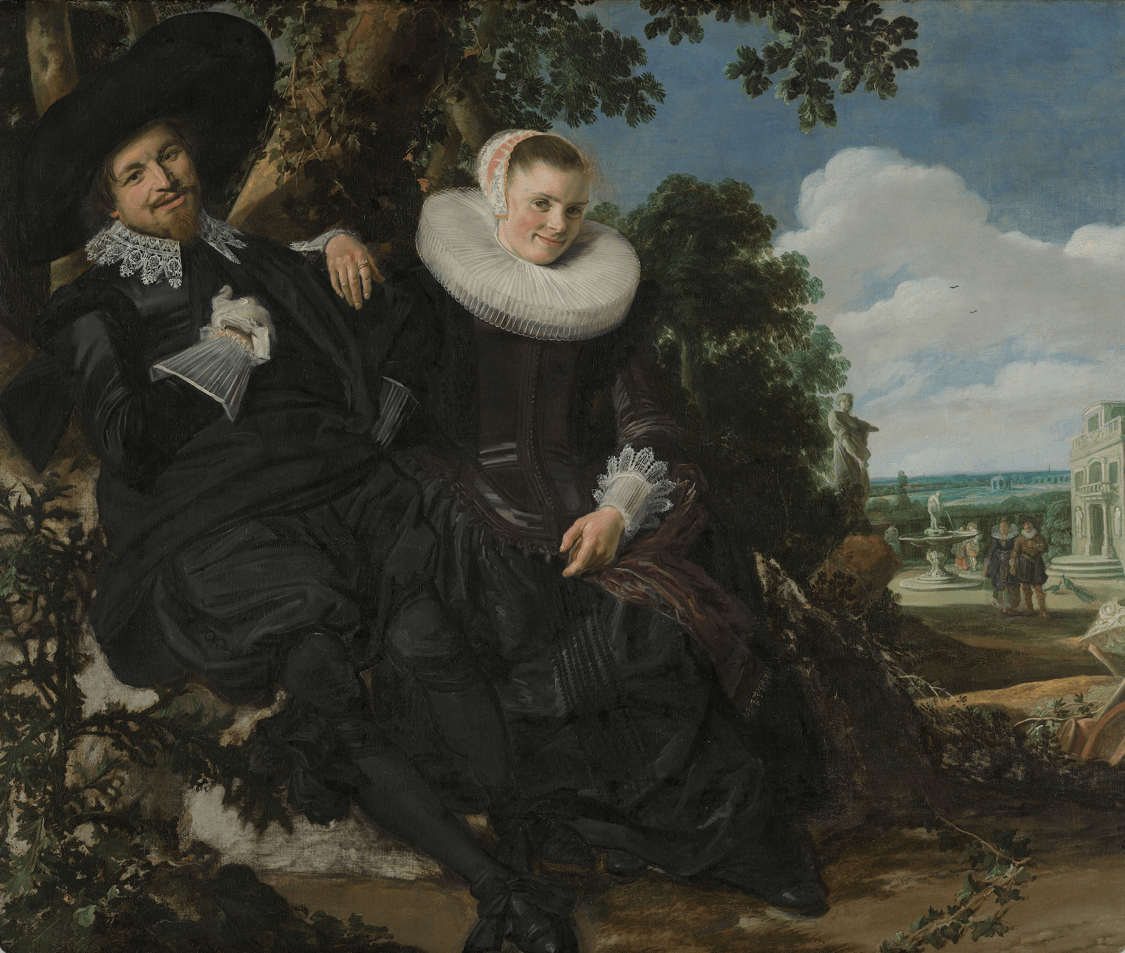
Frans Hals, Portrait of a Couple (Isaak Abrahamsz Massa and Beatrix van der Laen), c. 1622, Amsterdam, Rijksmuseum.
One of the most engaging of these is the Portrait of a Couple, probably Isaak Abrahamsz Massa and Beatrix van der Laen. If it is indeed Isaac and Beatrix (the resemblance to documented portraits of Massa is strong), it was made to commemorate their marriage in 1622. Beatrix clings to her husband like the vine wrapped around the tree behind them. The Palace of Love at right and prickly thistle at left may refer to the traditional marriage vows “for better or for worse.” Though these allusions to wedlock are conventional, Hals’ portrait is not. In traditional iconography, visible for example in Hendrick Goltzius’ A Marriage for Spiritual Love (1594), and even in Peter Paul Rubens’ spelndid Self-Portrait with Isabella Brandt (1610), the man and woman clasp each other’s right hand — the dextrarum iunctio – to signify their holy union. In Hals’ picture, the couple’s right hands are only proximate; hers rests on Isaac’s left shoulder and displays a gold and diamond wedding ring, while his is gloved and partly tucked into his vest. She is as confident, proud, pleased, and aroused as he is.
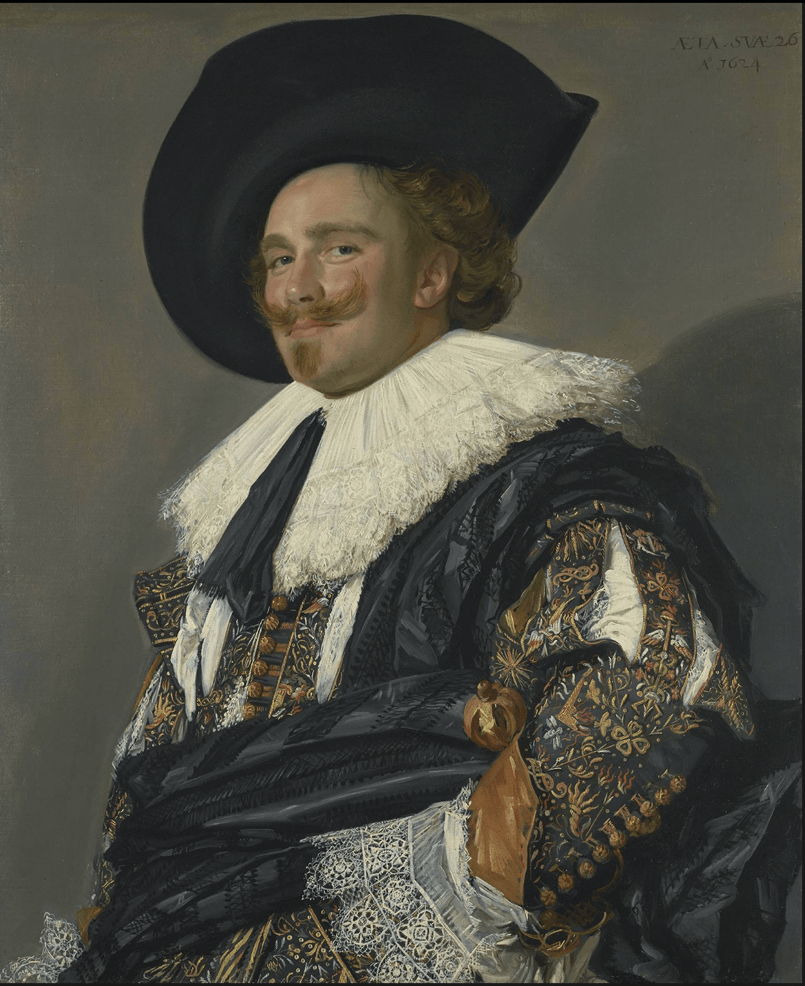
Frans Hals, Laughing Cavalier, 1624. Wallace Collection, London.
In Calvinist Holland, loud laughter was considered vulgar, though a soft or sweet chuckle was fine. Hals nevertheless specialized in painting laughing children, drunks, cackling women, and stage comedians. His Laughing Cavalier (1625) shows a wealthy young man wearing a discrete smile. But his upturned moustache and jauntily perched hat suggest broad laughter. The paint handling is itself a kind of boastful joke. It’s at once precise and detailed in the lace and embroidery, and loose and expressive in the black sash around the figure’s waist. Hals had such a mobile style, that he could in the same picture emulate the meticulous portraits of Michiel van Mierevelt and the freely brushed works of Anthony van Dyck. It’s worth noting here that Hals painted everything directly from life, without preliminary drawings or even rough sketches – none at least, have ever been identified. For him, painting and drawing were the same.
Late works
Dutch prosperity during the Golden Age was private, not public. Though there were important civic institutions, including universities, guilds, militias, and water boards, they were endowed by private funds. And while there was a tremendous amount of charity, it was mostly by burghers, the middling classes, and even the poor — the richest individuals were little taxed and offered only modest philanthropy. The Dutch Republic, like the contemporary U.S., was very charitable, but that did little to reduce gross disparities of wealth.
Indeed, economic precarity in the Dutch Republic impacted broad swaths of the population, including Hals himself. His determination to continue to develop a broad and expressive manner of portrait painting when that had largely gone out of style, meant that by the 1650s, he had few patrons. It’s documented that in 1655, he was unable to contribute money, as was customary, to support his son, Claes’ marriage. Also, that year, he joined the Dutch Reformed congregation, probably so he could be eligible for alms. A few years later, he received support from the Guild of St, Luke and the city of Haarlem, because of “his very urgent need.” Hals’ died in 1666, aged 84. His wife died in poverty soon after.
One of the organizations that supported Hals in his final years was the Old Men’s Alms House in Haarlem. They offered him two commissions — group portraits of their regents and regentesses.
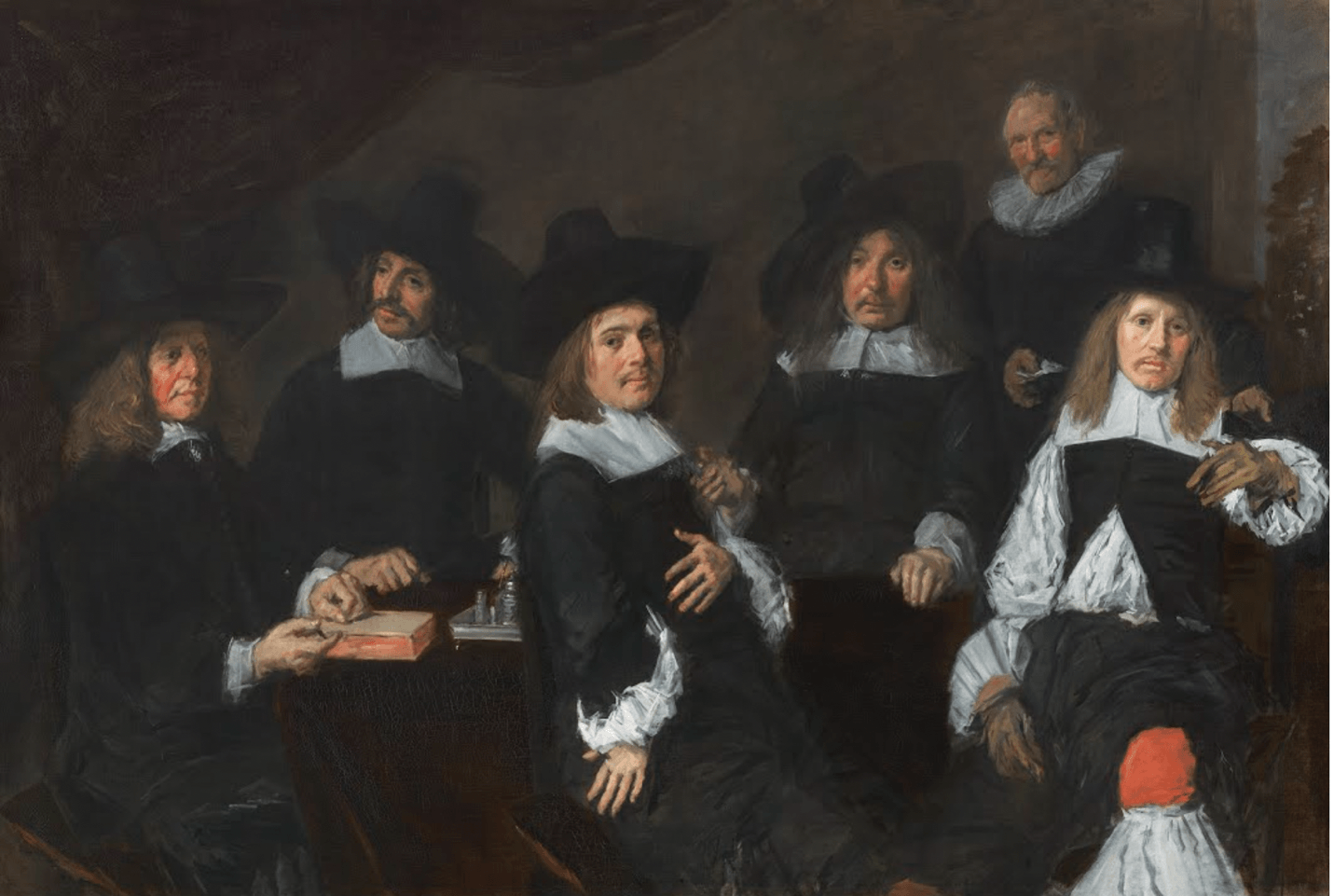
Frans Hals, The Regents of the Old Men’s Alms House, c. 1664. Frans Hals Museum, Haarlem.
The painting of the regents shows the five men who run the alms house, plus the attendant at the upper right in the old-fashioned ruffled collar. Hals depicts the regents in their typical costume – black robes with white collars and cuffs — in a dark interior. They are active and animated, each striking a different pose and looking in slightly different directions. (We know their names, but not who is who.) Note the faint smile of the man in the middle. Is it benevolence? And then there is the second regent from the right, with the tipped hat and drooping mouth. All we can safely say is that he looks at us directly and without pretense, just as the artist looked at him. The critic John Berger summed up the significance of this painting in his book, Ways of Seeing from 1972:
“In this confrontation the Regents and Regentesses stare at Hals, a destitute old painter who has lost his reputation and lives off public charity; he examines them through the eyes of a pauper who must nevertheless try to be objective, i.e., must try to surmount the way he sees as a pauper. This is the drama of these paintings….Hals was the first portraitist to paint the new characters and expressions created by capitalism. He did in pictorial terms what Balzac did two centuries later in literature.”
Living and working in a nation that issued a declaration of independence in 1581 – two hundred years before the Americans — conditioned Dutch citizens to expect the blessings of liberty. But state power, gross inequalities of wealth and status, and reliance upon a volatile market, meant that freedom was in fact available only to the few, not the many. That truth was manifest when Hals looked at the faces of the regents. He was likely reminded of what he had long “kept at a distance” in Freud’s words: his own and his family’s trauma and vulnerability when they fled Antwerp in the wake of the Spanish Fury. Now at the end of his life, what was repressed had returned: knowledge of his dependency upon others for sheer survival.
Rope
Philip Goldstein, later “Guston”, was born in 1913 to Jewish parents who in about 1905 emigrated to Montreal from somewhere in the Pale of Settlement. (Guston claimed Odessa, but that now appears unlikely.) Like other Jewish children of poor immigrants – like my parents — Guston understood otherness and social vulnerability. In 1922, the Goldstein family, including Philip and his six siblings, moved to Los Angeles to start a new life once again. A year later however, his father Louis, discouraged by his failure to find decent work, committed suicide. Philip claimed to have found the body, hanging by a rope from a rafter.
There was more trauma to come. Los Angeles in the 1920s and early ‘30s was a hotbed of anti-immigrant, anti-Black, anti-Catholic and anti-Semitic campaigning. The local KKK had tens of thousands of members, including prominent politicians, business leaders, police chiefs and county sheriffs. In 1922, the same year as Guston’s father’s suicide, a Klan attack in Inglewood attracted national attention. Two year later, several young Black men were taken from their Long Beach jail cells, tortured, and threatened with lynching. In 1930, John C. Porter, a former Klansman, was elected Los Angeles mayor. In response to these events, Guston produced a composition titled Conspirators, that shows a hooded Klan member examining a rope to be used for a lynching. In the background, a group of other Klansmen huddle together while a dead Black man hangs from a rope, beside a crucifix.

Philip Guston, Conspirators, 1930. Whitney Museum of American Art.
In 1932, Guston painted part of a mural for the local, communist-sympathetic John Reed Club, depicting a Klansman whipping a young Black man roped to a post. It was defaced a year later, probably by local Klan members in collaboration with police. Did Guston believe the Klan, with its virulent racism and anti-Semitism – and its deep ties to L.A. politics and society – was responsible for his father’s despair and suicide by rope? We don’t know; but Guston drew upon the painful memory of his dead father as means to create politically engaged art.
Zelig
From age 17 to about 55, Guston was a kind of Zelig or chameleon. He met everybody and absorbed everything around him. In 1930, the mature painter Lorser Feitelson took the teen to meet Walter and Louise Arensberg to see their collection of Cubist and Surrealist art. It made a big impression. The same year, Guston met Edward Weston – who photographed him. A year later, he joined the Hollywood John Reed Club and the year after that met the Mexican muralist David Alfaro Siqueiros, who was working on his controversial L.A. mural, América Tropical. In 1933, he travelled to Morelia, Mexico to paint an enormous mural called The Struggle Against War and Fascism which included several hooded Klan figures. After moving to New York City in 1936, Guston met everyone who matters in modern art and left politics. He painted a tondo called Bombardment, lamenting the Nazi bombing of Guernica. His art was derived from Pablo Picasso, the German New-Objectivity artist Max Beckmann, the Surrealist Max Ernst, the Neo-Romantic Pavel Tchelitchew, and the Social Realists Ben Shahn and Raphael and Moses Soyer. Guston was busy, unsettled, prodigious, and committed. He painted frescoes, murals and canvases on progressive themes.
In 1947, Guston suffered a spell of depression. After finding a path through it, he determined to give up representational painting. The WPA had long ended, Social Realism was deeply unfashionable – as was any painting that reeked of left politics – and artists were once again exploring abstraction. Guston’s high school friend Pollock had begun to drip and pour auto enamel on unstretched canvases laid on the floor. Barnett Newman was painting vertical lines and stripes over expressionist dreamscapes, and Mark Rothko was experimenting with large, stained canvases; soon he’d arrive at the motif – stacked oblongs — that would occupy him for the rest of his life. Existentialist philosophy told artists that a single brushstroke could be expressive of being; formalist critics argued that paintings were nothing more than surface, line, shape and color; and art dealers insisted that American painters and sculptors had to innovate or be beaten out of the market by Europeans. Guston got with the program. The Tormentors (1947), which feels like a response to his depression, still has a trace of Klan imagery – a sketchy hood contour scratched into the mauve-brown. But White Painting (1951) does not, and neither does Voyage, painted five years later.
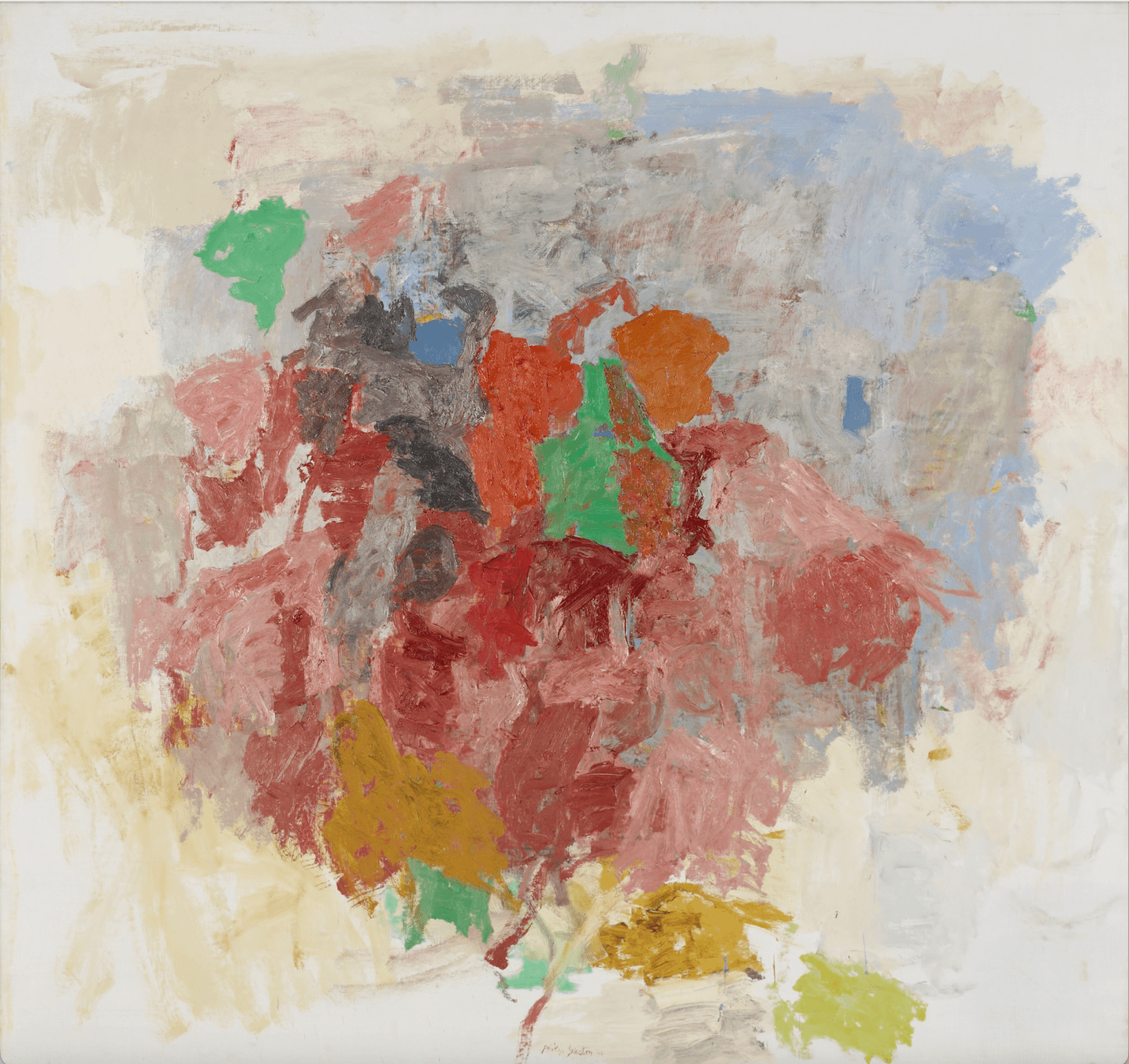
Philip Guston, Voyage, 1956. Buffalo, AKG Museum.
Voyage is typical of Guston’s best work of this decade and the next. It’s composed of large, irregular daubs or lozenges of paint, pressed together, almost jostling. They are closely hued and valued – rose, pink, red, grey and ochre — with sections of green-turquoise standing out from the rest. All the action is in the middle, suggesting that the artist worked close to the six-foot square canvas, and rarely stepped back: He didn’t allow himself to see the forest for the trees. “This ‘thing’ is recognized only as it comes into existence” Guston wrote at the time, paraphrasing Sartre’s famous formula, “existence precedes essence.” Guston continued: “I am on a work . . . until . . . the paint falls into positions that feel destined.” Successful as these paintings were – both artistically and commercially — Guston was working at cross purpose to his own genius. Rather than deploying his deep insights into the nature of alienation, power, oppression, and resistance, he chose to erase as far as was possible, any reference to them. This was an art of repression, and Guston eventually understood it to be so.
“Failed” repression
In an essay from 1915, Freud argued that repression was “exceedingly mobile [and] …not to be regarded as an event which takes place once…. the repressed exercises a continuous pressure in the direction of the conscious, so that this pressure must be balanced by an unceasing counter-pressure.” When the work of repression fails, the repressed content may flood into consciousness and cause morbid symptoms.
But not always. If that repressed content is disguised or distorted just enough, it may enter consciousness (the ego) in the form of “derivatives” that are sometimes highly creative. That’s the stuff of jokes, dreams, poetry, music, and visual arts. After about 1969, Guston once again deployed motifs and themes – Klansmen, isolated figures, menace, alienation, mortality – that had been repressed since 1947. The results were funny, gross, tragic, and sometimes politically trenchant. The breakthrough picture was The Studio (1969) which depicts a hooded artist painting a self-portrait. He smokes a cigarette — Guston chain-smoked — and is surrounded by the accoutrements of the artist’s Woodstock, New York studio: easel, brushes in a can, clock, light bulb, window with green shade half-pulled down. It’s satirical, recalling Francisco Goya’s Capricho 39, “And so was his grandfather,” showing a donkey (an ass) consulting book of genealogy that’s filled with pictures of more donkeys. It’s also topical. Richard Nixon had just been elected president on the platforms of “law and order” and “the forgotten Americans,”
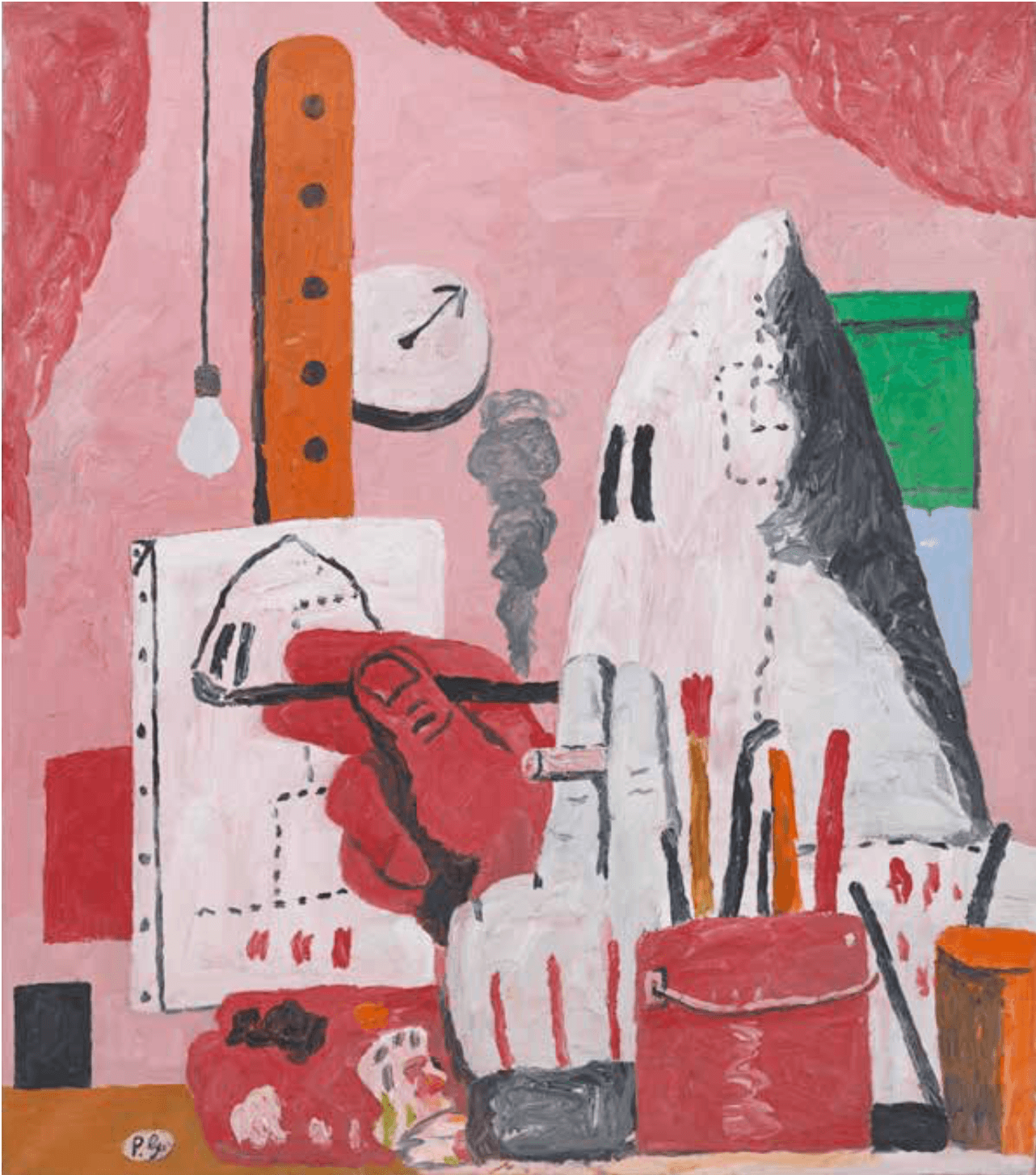
Philip Guston, The Studio, 1969. Private collection.
which were barely disguised appeals to white voters opposed to further action on civil rights and urban (Black) unemployment and poverty. In the wake of the elections, Guston asked if Americans had once again donned Klan hoods and robes. Had Guston, despite his hatred of Nixon, somehow done the same?
For the next decade – his last — Guston expanded his range of motifs and references to include cyclopean figures, household items, hand, legs, and shoes. Painters Forms II (1978) depicts a giant, disembodied, open mouth at left, appearing to devour or disgorge long, tubular, leg-
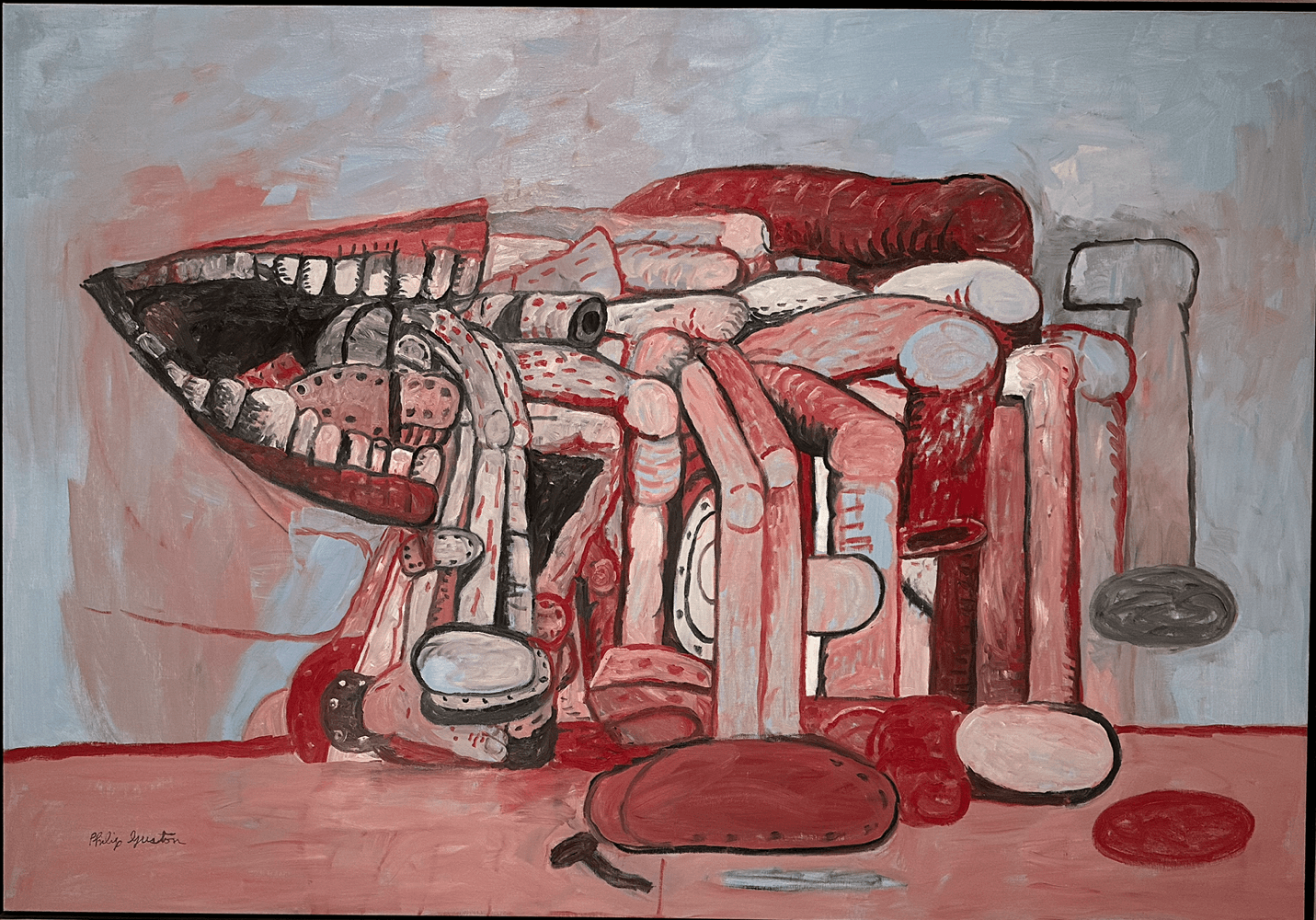
Philip Guston, Painter’s Forms II, 1978. Modern Art Museum of Fort Worth.
cigarettes that terminate in oval clown shoes. Many of the legs are jointed at the knee – there are no ankles – and some have flecks of red or grey, resembing hair. The whole thing suggests a vagina dentata, the devouring female genital discussed by Freud in his essay “Screen Memories,” in Three Essays on the Theory of Sexuality (1905). But the mouth may just as well be the Guston’s own, along with the numberless cigarettes he smoked that would, (along with copious amounts of booze), kill him in 1980. “Sometimes a cigar is just a cigar,” as Freud never said.
Postscript
The repressed source of my experience of déjà vu in Freud’s study is by now easy to guess. It was the death of my father and my own mortal fears. Bertram Eisenman died in 1986, aged 73, from the thousands of cigars he smoked. As a child in our small apartment in Forest Hills, Queens, tobacco smoke was a constant companion. Every carpet and piece of furniture reeked of cigar smoke. It was awful, but also uncannily comforting. The smell created a feeling of being closed in and protected from the outside world. I must have felt something similar in the Freud’s dark, heavily carpeted, and over furnished study in Hampstead.
Hals and Guston too contributed to my déjà vu – my return of my repressed. Hals was always on the verge of bankruptcy – as was my dad when I was growing up. I thought of that fact while looking at the late works in the National Gallery exhibition, and the thought may have lingered just below my consciousness a few hours later at the Freud Museum.
Guston, like Bertram, was a Jew and the child of immigrants. He knew some Yiddish, like my father, was on the left, like him, and hated Nixon – that was a given. Guston was a smoker – it killed him too. I remember the day Guston died, aged 67, thinking he lived a long and productive life. I’m 67 now, and after concluding my visit to Guston’s retrospective, I thought what a tragedy it was — he died in the prime of life.



